Stream exclusive talks and presentations, covering key AI topics and trends, and hosted by industry experts and leaders….
Wipro and IBM collaborate to propel enterprise AI
In a bid to accelerate the adoption of AI in the enterprise sector, Wipro has unveiled its latest offering that leverages the capabilities of IBM’s watsonx AI and data platform. The extended partnership between Wipro and IBM combines the former’s extensive industry expertise with IBM’s leading…
Microsoft is quadrupling its AI and cloud investment in Spain
Microsoft has announced plans to significantly boost its investment in AI and cloud infrastructure in Spain, with a commitment to quadruple its spending during 2024-2025 to reach $2.1 billion. This substantial increase marks the largest investment by Microsoft in Spain since its establishment in the country…
Switch Successor Targeting March 2025, According To New Report

Japanese outlet Nikkei is reporting that the Switch successor, or “Switch 2” as it’s been dubbed colloquially within the games industry, is targeting a March 2025 launch, according to VideoGamesChronicle. This report follows earlier reporting from VGC and other outlets like Eurogamer that Nintendo’s next console was originally targeting a 2024 launch before being pushed internally to the first quarter of 2025, which lines up with Nikkei’s latest reporting.
[embedded content]
VGC reports that Nikkei writes, “Priority was given to ensure the initial inventory of the successor console and a lineup of software titles at the time of its launch” to curb the possibility of a stock shortage similar to what the PlayStation 5 and Xbox Series X/S experienced back in 2020. Following previous reports, Nikkei also writes that Nintendo’s next console will be a hybrid home console-portable device like the Switch with a larger screen.
Finally, Nikkei writes the internal target is March 2025 but that the Switch 2 could slip beyond that depending on manufacturing and the software available for the console’s launch at that time, according to VGC. If it does launch in March of next year, it’d follow in the Switch’s footsteps, which launched in March of 2017.
It’s important to note that all of this should be taken with a grain of salt as these delays remain internal for the time being. The Switch’s successor hasn’t even been publicly revealed yet, so there’s no telling when to expect it officially. In the meantime, though, read about how Nintendo reportedly demoed the Switch successor to developers at Gamescom last year.
[Source: Nikkei via VideoGamesChronicle]
Do you think March of next year is a good time for a new Nintendo console? Let us know in the comments below!
Reynatis, That Cool Looking Action Game Shown During Last Week’s Japanese Nintendo Direct, Hits The States This Fall
During last week’s Nintendo Direct: Partner Showcase, we learned Grounded and Pentiment, two Xbox titles, are coming to Switch, Disney Epic Mickey was getting the remaster treatment, Penny’s Big Breakaway is now available, and more. You can check out our full rundown of everything announced during the Partner Showcase here. However, Reynatis, a really cool-looking action game set in a modern-day Tokyo, was not shown.

It appeared during the Japanese version of the Partner Showcase, though, and the game quickly picked up steam online, thanks to its cool visual style, over-the-top action, and music by Final Fantasy XV composer Yoko Shimomura. Despite its absence on the English version of the Partner Showcase, we now know Reynatis is coming West later this year.
Specifically, it’s due out this fall on PlayStation 5, PlayStation 4, Switch, and PC via Steam, as reported by Gematsu.
Check out the Reynatis reveal trailer for yourself below for a glimpse at what to expect:
[embedded content]
“Fantasy meets reality in Shibuya, Tokyo, where magic is something to be feared,” the game’s description on Steam reads. “In this action RPG, a young wizard seeks freedom through strength, and an officer seeks to control magic and restore order. When their paths cross, a darkness that will transform the world descends.”
Elsewhere on Steam, developer Furyu Corporation and publisher NIS America write that Reynatis is set in 2024, and the Criminal Magic Response Act is an order that bars citizens from going out at night – few enforce the rule though.
“Marin Kirizumi is a wizard who grew up oppressed by others due to his magic,” the game’s description reads. “‘If you become the strongest, you’ll be set free.’ Following these words left by his father, he arrives in Shibuya at night.
“When Sari Nishijima discovered her magic, she decided to use her powers to maintain order. She follows her own sense of justice to protect Shibuya from forces with dangerous ideals and illegal drugs that turn people into monsters. Marin, who seeks liberation. Sari, who treats the oppression of wizards as justice. The story of Reynatis begins when the two meet in Shibuya, a place where cultures and ideas mix.”
Reynatis is due out this fall on PS5, PS4, Switch, and PC. It will support Japanese audio with English text.
[Source: Gematsu]
What do you think of Raynatis? Let us know in the comments below!
Until Dawn, Little Nightmares III Developer Supermassive Games Is Laying Off 90 Employees

Supermassive Games, the developer behind Until Dawn, The Quarry, and the upcoming Little Nightmares III, is laying off roughly 90 employees, according to a new report from Bloomberg. The publication reports that 150 staff members at the British studio were informed today they are “at risk” of being laid off in accordance with U.K. labor laws that require companies to give notice ahead of layoffs.
Shortly after Bloomberg’s report went live, the studio tweeted the following statement:
It’s no secret that the games industry is currently facing significant challenges, and unfortunately we aren’t immune to this.
After much deliberation and with deep regret, we are therefore undertaking a reorganization of Supermassive Games. As a result, we are entering into a period of consultation, which we anticipate will result in the loss of some of our colleagues.
This is not a decision that’s been taken lightly, with many efforts made to avoid this outcome.
We are all too aware of how unsettling and difficult this process is going to be for all our employees and will be working closely with all those involved to ensure the process is conducted as respectfully and compassionately as possible.
We’re committed to focusing our efforts on our core strength and upcoming titles to ensure the continued sustainability of the company.”
Bloomberg reports that Supermassive is made up of 300 employees, meaning laying off 90 people would equal a roughly 30 percent reduction in staff. Despite developing PlayStation exclusives like Until Dawn, Supermassive is part of Nordisk Games.
Last month, PlayStation announced that an Until Dawn remake is coming to PS5 and PC later this year, although UK developer Ballistic Moon is the primary team working on that. Supermassive is, however, developing Little Nightmares III, which is due out this year.
These job cuts join a string of other disheartening 2024 layoffs, which total more than 5,500 in just the first two months of the year. At the end of January, we learned Embracer Group had canceled a new Deus Ex game in development at Eidos-Montréal and laid off 97 employees in the process. Also in January, Destroy All Humans remake developer Black Forest Games reportedly laid off 50 employees and Microsoft announced it was laying off 1,900 employees across its Xbox, Activision Blizzard, and ZeniMax teams as well. Outriders studio People Can Fly laid off more than 30 employees in January, and League of Legends company Riot Games laid off 530 employees.
We recently learned Lords of the Fallen Publisher CI Games was laying off 10 percent of its staff, that Unity would be laying off 1,800 people by the end of March, and that Twitch had laid off 500 employees.
We also learned that Discord had laid off 170 employees, that layoffs happened at PTW, a support studio that’s worked with companies like Blizzard and Capcom, and that SteamWorld Build company, Thunderful Group, let go of roughly 100 people. Dead by Daylight developer Behaviour Interactive also reportedly laid off 45 people, too.
Last year, more than 10,000 people in the games industry or game-adjacent industries were laid off.
In January of last year, Microsoft laid off 10,000 employees amidst its ongoing $69 billion acquisition of Activision Blizzard, which it completed in October.
Striking Distance Studios, the team behind 2022’s The Callisto Protocol, laid off more than 30 employees in August of 2023. That same month, Mass Effect and Dragon Age developer BioWare laid off 50 employees, including long-time studio veterans. The following month, in September, Immortals of Aveum developer Ascendant Studios laid off roughly 45% of its staff, and Fortnite developer Epic Games laid off 830 employees.
In October of last year, The Last of Us developer Naughty Dog laid off at least 25 employees, and Telltale Games also underwent layoffs, although an actual number of affected employees has not yet been revealed. Dreams developer Media Molecule laid off 20 employees in late October.
In November, Amazon Games laid off 180 staff members, Ubisoft laid off more than 100 employees, Bungie laid off roughly 100 developers, and 505 Games’ parent company, Digital Bros, laid off 30% of its staff.
In December, Embracer Group closed its reformed TimeSplitters studio, Free Radical Design, and earlier in the year, Embracer closed Saints Row developer Volition Games, a studio with more than 30 years of development history. A few weeks before the winter holidays, Dungeons & Dragons and Magic: The Gathering owner Hasbro laid off 1,100 employees.
The games industry will surely feel the effects of such horrific layoffs for years to come. The hearts of the Game Informer staff are with everyone who’s been affected by layoffs or closures.
[Source: Bloomberg]
How The Developers Of Unicorn Overlord Are Making A Return To Fantasy
Vanillaware makes excellent games, from GrimGrimoire to Odin Sphere to Dragon’s Crown. However, it wasn’t until its 2019 release, 13 Sentinels: Aegis Rim, that the developer’s name became synonymous with “you should play this team’s games.” It’s hard to tell what, exactly, made 13 Sentinels the breakout title for Vanillaware, shipping more than 1 million copies worldwide as of August last year, making it the studio’s best-selling title. The easy answer is probably its beloved story, both in how it plays out and how it’s infused into the game’s real-time strategy mech combat.
Publisher Atlus and Vanillaware released it in 2019, so when the team announced its latest title, Unicorn Overlord, last September, it was easy to conclude that this was the studio’s next big focus. And it is, but curiously, I learned in an exclusive preview of the game Vanillaware conceived it during the development of 13 Sentinels, with its creation handled in parallel with that game, albeit with a different team and director.
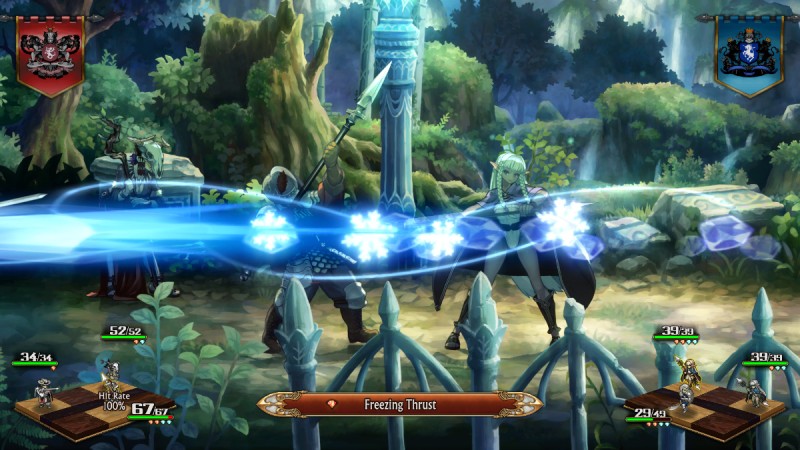
“[It] was not a change of genre, but rather a team effort to create a worldview that was originally based on the premise of a fantasy,” lead game designer Wataru Nakanishi tells me over email after I watch roughly an hour of live Unicorn Overlord gameplay. Notably, the game isn’t a response to the sci-fi modern action of 13 Sentinels as I expected; the team wanted to make another fantasy game, which checks out considering that’s where its roots lie, dating back to its debut game, 2007’s GrimGrimoire. Looking at Vanillaware’s history, it’s 13 Sentinels that stands out as the oddball fit, with most of the studio’s games falling into the fantasy camp.
Nakanishi says Unicorn Overlord is Vanillaware’s spin on the tactical fantasy RPG, and that’s immediately clear in the opening hour. Protagonist Alain is around 10 years old in the prologue, when he and the Queen of Cornia, Ilenia, witness a rebellion at the hands of one of her trusted generals. Worried about the kingdom’s fate and bloodline, her most trusted knight, Josef, is tasked with spiriting the prince away to safety. The main game’s story picks up 10 years later; Crown Prince Alain is around 20 years old, living on the island of Palevia, where he’s grown up since the rebellion. While sparring with his friend Lex, a ship flying Zenoiran colors sails into the harbor and it’s clear they mean no good.

Immediately, I’m in love with the score, which oscillates between medieval choruses and an orchestral mix of horns, winds, and other instruments typical of the genre. Nakanishi tells me the independent music group Basiscape, who scored 13 Sentinels under the direction of composer Hitoshi Sakimoto, is returning to create the musical soundscape of Unicorn Overlord, this time under Mitsuhiro Kaneda, who also worked on 13 Sentinels’ score. Nakanishi says Kaneda’s score has a “newness that befits the name, ‘Rebirth of tactical fantasy RPGs,’” which is something the team mentions various times when discussing the game. The statement is a bold one and, taken at face value, almost arrogant. But Nakanishi clears it up humbly.
“[That statement] reflects the fact that this is a challenging title created in the tactical RPG genre, which we have always loved, with new challenges, and that we want to convey this to our players in a straightforward and correct manner,” he says. “We are making various efforts to make the game accessible to people who have never played this genre before.”
After my hour of gameplay, that’s a somewhat tall order. The genre is historically one of the more complex to get into, and my initial impression of Unicorn Overlord is that newcomers might find it overwhelming, perhaps even odd at first. You don’t necessarily control the individual fights that happen in combat encounters – instead, you determine where you want to move on the “tactical battle map.” Bumping into an enemy makes battle inevitable, but before said battle takes place, you can essentially look into the future to see how it plays out by checking unit formation, which skills they have set up, and more.
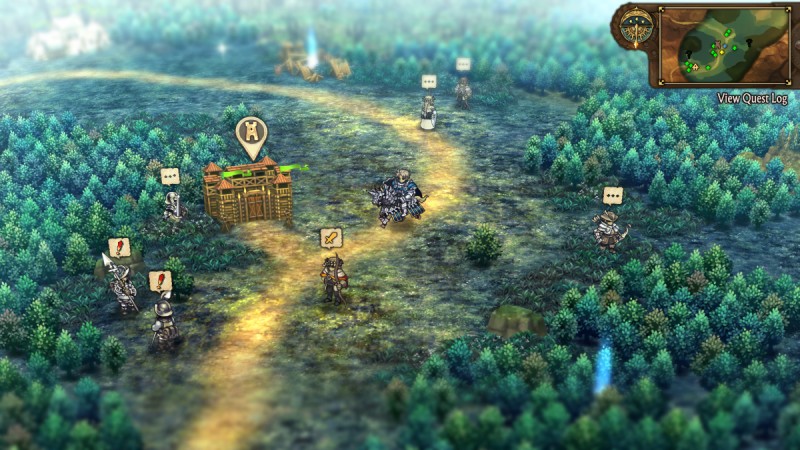
After all checks are in place, and after checking with a statistic measure that tells you how they might fair in battle in a Fire Emblem-esque way, the battle begins; you do not participate but instead, watch what happens. Success comes from active skills, which use points regenerated between skirmishes, and passive skills, which trigger in combat when certain conditions are met. For example, one passive skill I see heals a unit’s character at the end of a battle, a critical tool as health does not regenerate between bouts.
Back on the beautifully illustrated tactical battle map, I watch a complete battle stage, which features its own win-loss conditions, play out. The player first interacts with the Command Post, where they deploy units based on Valor points they have available to spend. Vanillaware tells me liberating towns and fortresses and defeating enemies earns more of these. You can also spend these points on special Valor Skills, which apply unique buffs inside and outside combat. From here, Unicorn Overlord plays almost like a board game, where you must tactically place your various units on the map – each comprised of different characters and companions with their own use case – and move them accordingly.
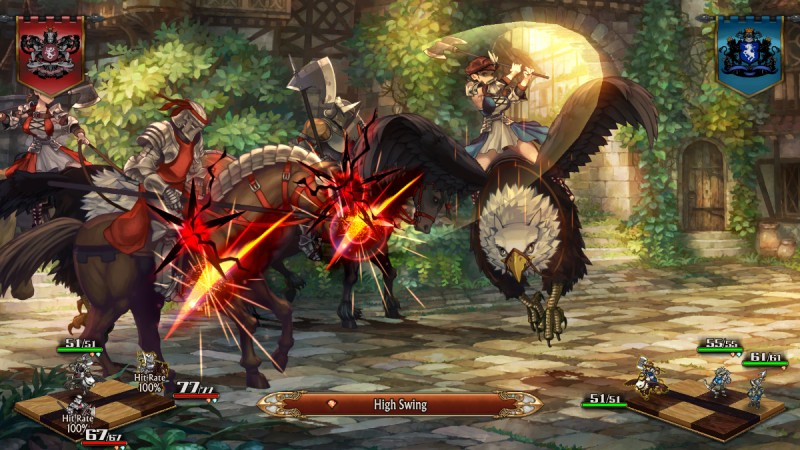
Admittedly, it’s all quite confusing as I’m thrown directly hands-off into the mix, but I do witness many tutorial messages and screens we skip over for the sake of time. Nakanishi assures me Unicorn Overlord features a lot of in-game support, including “tutorials, recommended composition examples, automatic equipment, strategy settings, and switching difficulty levels so that as many people as possible can enjoy the most exciting parts of the game […] without becoming overwhelmed.”
Once an encounter begins, either by your own unit running into an enemy or vice versa, an initiative order determines when combatants attack, and the entire battle continues until the enemy (or you) are defeated or all combatants run out of action points. In the latter scenario, the side with the most health remaining claims victory. The more of it I see, the more I appreciate its cinematic approach – I, the player, set the pieces onto the board and then watch the strategic planning (or chaos) pay off, hopefully in a win. Nakanishi says the draw of this type of gameplay is immersion.
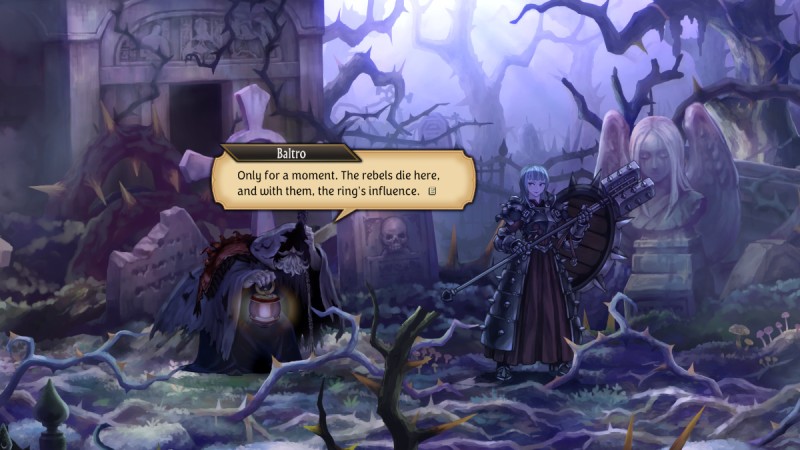
“[In] the case of tactical RPGs, the combination of a strategy element, in which you have a bird’s eye view of the battlefield and make precise, step-by-step moves, and the role-playing element, in which you become attached to the characters living in the world and fight alongside them, is a game genre that offers the greatest sense of immersion,” he says. “This is the main attraction, and the team places great importance on this kind of game experience.”
After a few fights in this preliminary stage early in the game’s opening hours, we liberate a Palevian town under Zenoira, switching it from a red flag to our blue flag, picking up two Valor points in the process. This newly liberated town is now a base from which we can deploy units. We advance through the stage, using Josef to cover extra ground as movement takes place in real time, and he moves the fastest, while swapping allies in and out of various units once two units are within the radius of a special green circle on the tactical battle map. Vanillaware says it’s essential to take advantage of this feature, as damaged allies might need to fall back while more adept ones, like a companion that uses magic (or magick as it’s called in the game), or another with high stamina indicated by the number on an on-screen shield, head to the front of a unit’s pack.

Within each unit is a player-created makeup of classes, too, which might determine how you advance them on the tactical battle map. Horseback cavalry are excellent against Infantry, a standard soldier, as are Knights. With their great shield, Hoplite classes offer high defense. They are suitable for protecting an area or unit, so countering with a high agility class is extra important when facing one.
Outside of fights, players can use items to heal or buff companions, change a loadout and equipment, and more. And all of this – the combat of Unicorn Overlord – is just one half of the experience, with the other being exploration.
“On the overworld, big goals are always clearly presented, and players decide on their own how to achieve them,” Nakanishi says. “Facilities such as towns and forts around the world are controlled by the main enemy called the New Zenoiran Empire, and while exploring the overworld, you can recruit allies, procure equipment and items, and make preparations while liberating towns. Various quests and events will occur along the way, but it is up to the player to decide in what order and how to complete them, so depending on the situation of the troops […], you may sometimes have to avoid them or postpone them.”

On that note, Vanillaware expects players to roll credits at 50 hours, but completionists can expect upwards of 100.
I’m not entirely sold on the combat and exploration, but that’s because I haven’t yet played it for myself. It looks interesting from a mechanical standpoint, and it’s certainly unique. If Vanillaware has made one thing clear in its portfolio, it’s that the studio has little regard for trends; it marches to the beat of its own drum within familiar genres, even if they’re niche.
“Games that we find interesting from the bottom of our hearts tend to be from genres that are considered niche,” Nakanishi says. “So rather than intentionally choosing those genres, it’s because we just happen to like them. However, no matter the genre, it is meaningless if the customers who purchase it cannot find it interesting, so we always focus on ensuring the game we’re producing is understandable and enjoyable to play.”

Niche or not, Unicorn Overlord is a treat for the eyes. Classic SNES RPGs of yesteryear inspire Vanillaware this time around, Nakanishi tells me, and the studio wants Unicorn Overlord to look like one of those games but on a modern platform, complete with a full suite of English or Japanese voice over. The art design, born from a single piece of concept art, is meant to evoke that period’s games, somewhere between retro and painterly. That piece of art is also the game’s title screen. “Based on this illustration, the character designs for battle were decided, battle backgrounds were drawn, and the overall art style came together,” he adds.
All of this only scratches the surface of what I saw in that first hour of Unicorn Overlord gameplay. There’s plenty of story crammed into it – a story not worth spoiling here since the narrative is a big draw for many Vanillaware fans – and an intense number of menus RPG fans will surely love digging into the minutiae of. There are more than 60 companions to recruit freely throughout the campaign, depending on how you tackle the game’s more open nature of progression, and lots of great music and visuals to accompany it if what I’ve already heard and seen is any indication. In short, there’s still a lot of game to uncover in Unicorn Overlord, and even after an hour and a lengthy interview, it feels as if I’ve barely wrapped my head around this tactical fantasy RPG experience. With little time to go until its release next month, I’m excited to see what Vanillaware can do with its return to the fantasy genre, where its history began almost two decades ago.
This article originally appeared in Issue 363 of Game Informer
EA Lays Off 670 Employees, Cancels Respawn’s Star Wars FPS
Electronic Arts is laying off 5 percent of its workforce, which accounts for roughly 670 employees. CEO Andrew Wilson issued a company-wide letter informing staff of the publisher’s restructuring, which will mean sunsetting some live service titles and ceasing the development of certain projects.
In his letter, Wilson states that EA is restructuring to become more streamlined in order to deliver “deeper, more connected experiences for fans everywhere that build community, shape culture, and grow fandom.” To that end, the company will be moving away from licensed IPs and shutting down certain titles to shift its development resources.
“We are also sunsetting games and moving away from the development of future licensed IP that we do not believe will be successful in our changing industry,” says Wilson in the letter. “This greater focus allows us to drive creativity, accelerate innovation, and double down on our biggest opportunities — including our owned IP, sports, and massive online communities — to deliver the entertainment players want today and tomorrow.”
Wilson then speaks to the extent of the layoffs and how it will work with affected employees:
“While not every team will be impacted, this is the hardest part of these changes, and we have deeply considered every option to try and limit impacts to our teams. Our primary goal is to provide team members with opportunities to find new roles and paths to transition onto other projects. Where that’s not possible, we will support and work with each colleague with the utmost attention, care, and respect.”
He states that this restructuring is expected to be completed by early next quarter. Last March, EA cut 6 percent of its global workforce. Studios such as Bioware and Respawn were also hit with internal layoffs.
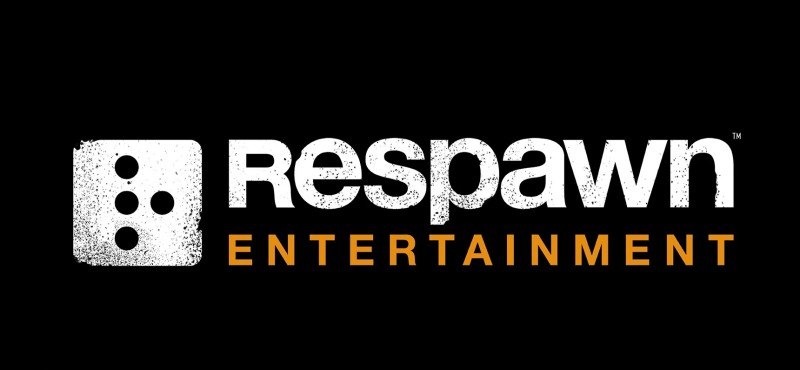
As reported by Video Games Chronicle, one confirmed casualty of this change is Respawn’s upcoming Stars Wars first-person shooter. First announced to be in development in January 2022, the unnamed game was led by Medal of Honor co-creator and Star Wars Battlefront veteran Peter Hirschmann. Recent rumors suggested that it may have starred a Mandalorian bounty hunter.
In a statement to VGC, EA Entertainment president Laura Miele said in part, “It’s always hard to walk away from a project, and this decision is not a reflection of the team’s talent, tenacity, or passion they have for the game. Giving fans the next installments of the iconic franchises they want is the definition of blockbuster storytelling and the right place to focus.”
EA’s other upcoming licensed projects include Motive’s Iron Man and Cliffhanger’s Black Panther. An EA representative confirmed to GameIndustry.biz that both projects are still in development.
[embedded content]
These job cuts join a string of other disheartening 2024 layoffs, which now total more than 8,000 in just the first two months of the year. PlayStation is laying off 900 employees across Insomniac, Naughty Dog, Guerrilla, and more, closing down London Studio in the process, too. The day before, Until Dawn developer Supermassive Games announced it is laying off 90 employees.
At the end of January, we learned Embracer Group had canceled a new Deus Ex game in development at Eidos-Montréal and laid off 97 employees in the process. Also in January, Destroy All Humans remake developer Black Forest Games reportedly laid off 50 employees and Microsoft announced it was laying off 1,900 employees across its Xbox, Activision Blizzard, and ZeniMax teams as well. Outriders studio People Can Fly laid off more than 30 employees in January, and League of Legends company Riot Games laid off 530 employees.
We recently learned Lords of the Fallen Publisher CI Games was laying off 10 percent of its staff, that Unity would be laying off 1,800 people by the end of March, and that Twitch had laid off 500 employees.
We also learned that Discord had laid off 170 employees, that layoffs happened at PTW, a support studio that’s worked with companies like Blizzard and Capcom, and that SteamWorld Build company, Thunderful Group, let go of roughly 100 people. Dead by Daylight developer Behaviour Interactive also reportedly laid off 45 people, too.
Last year, more than 10,000 people in the games industry or game-adjacent industries were laid off.
Atomos Releases AtomOS11 and Feature Packs for the Ninja V / V+ – Videoguys

Atomos Ninja V and Ninja V+ users now have access to the latest AtomOS 11 update, bringing a refreshed user interface to their monitor-recorders. Unlocking new features requires purchasing a separate Feature Pack. These Feature Packs are available at a limited-time offer of $79 USD for Ninja V and $129 USD for Ninja V+. With this update, Atomos is signaling a shift away from supporting AtomOS 10, possibly necessitating users to transition to AtomOS 11 for future firmware updates.
Ninja V Feature Pack includes:
- EL ZONE
- ARRI False Color
- SegmentPro
- PlaybackAssist
- RecordAssist
- Wi-Fi 6
Ninja V+ Feature Pack includes:
- EL ZONE
- ARRI False Color
- SegmentPro
- PlaybackAssist
- RecordAssist
- Wi-Fi 6E
- ProRes RAW Dual Record
- SDI Cine
The Feature Packs not only unlock new functionalities but also include valuable additions such as H.265 and ProRes RAW Codecs, which individually would typically cost users $198 USD. This ensures that users get comprehensive enhancements to their Ninja devices, enhancing their workflow and capabilities. Furthermore, until the end of March 2024, existing Ninja monitor-recorder owners can take advantage of a special offer to purchase Atomos Connect for $99 USD, excluding local sales taxes, providing additional connectivity options for their setups.
For those investing in Atomos connected monitor-recorders like the Zato Connect, Shogun, or Shogun Ultra, registering the device brings additional benefits. Upon registration, purchasers can access a complimentary 6-month Camera to Cloud plan on Atomos Cloud Studio, a service valued at $15 USD per month. This offer underscores Atomos’s commitment to providing value-added services and ensuring users maximize the potential of their equipment. Stay informed and make the most of these offerings to elevate your Atomos experience and stay ahead in your creative endeavors.
Read the full article by Matthew Allard for NewsShooter HERE
PTZOptics PTZ Cameras Transform Worship Streaming Experience – Videoguys

In the bustling world of church production, finding reliable, versatile equipment is paramount. Bethany Place Baptist Church in Chesterfield, Virginia, discovered the transformative power of PTZOptics cameras early on. With a commitment to quality and budget-conscious decisions, the church opted for PTZOptics cameras over manned alternatives, relying on these robust units for all their streaming needs.
Andrew Ryan, a dedicated volunteer on the production team at Bethany Place Baptist Church, attests to the unwavering performance of PTZOptics cameras. “We have never had an issue with them,” Ryan emphasizes. “They’re rock solid. They connect easily. Everything is controlled over IP.” The seamless integration with multiple streaming software and the user-friendly PTZ function via the web interface make these cameras a standout choice for churches relying on volunteer staff.
As part of Church Production’s Road Test User Experience, Bethany Place had the opportunity to test the new Move 4K cameras and SuperJoy Controller from PTZOptics. Ryan praises the solidity of these units, noting their resilience to vibrations, a crucial aspect in a dynamic church environment. The strategic placement of the cameras allowed for seamless transitions between different shots, enhancing the visual narrative of the services.
The plug-and-play nature of the cameras, coupled with features like NDI compatibility and 30X zoom capability, impressed Ryan and his team. “The 30X zoom is wonderful,” Ryan enthuses, highlighting its utility across various room sizes. Moreover, the potential for 4K recording and streaming opens doors for future expansion and growth, aligning perfectly with Bethany Place’s vision.
Ryan also shares insights into the SuperJoy Controller, commending its intuitive design and user-friendly features. The oversized focus and exposure knobs, along with precise PTZ control, streamline the production process, empowering volunteers to deliver professional-quality content effortlessly. Features like focus lock and exposure controls further enhance flexibility and adaptability, ensuring optimal performance in diverse lighting conditions.
From worship services to choir concerts, PTZOptics cameras have proven their versatility in countless applications at Bethany Place Baptist Church. “At this point, they work basically in any application, in any lighting,” Ryan confirms, underscoring the reliability and adaptability of these cameras.
In conclusion, Bethany Place Baptist Church’s journey with PTZOptics cameras exemplifies the transformative impact of innovative technology in the realm of church production. With steadfast performance, intuitive controls, and unparalleled versatility, PTZOptics cameras continue to elevate the worship experience, one frame at a time.
[embedded content]
Read the full blog post by Deidra Blackmore for ChurchProduction HERE
